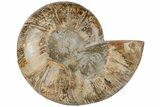This Specimen has been sold.
9" Cut & Polished Ammonite Fossil (Half) - Jurassic
This is a large, 9" wide, cut and polished ammonite fossil collected near Sakaraha in the Tulear Province of Madagascar. This colorful ammonite is Late Jurassic in age, or approximately 160 million years old. It's some genus of Phylloceratida, possibly Lobolytoceras.
The previously hollow chambers of the ammonite were replaced with a beautiful agate during the fossilization process. Some of these chambers are still partially hollow and lined with druzy crystals. The ammonite was cut in half and polished revealing the inner chamber structure of this ancient marine animal. There has been some repair work as these larger ammonites are almost always fractured while in the ground.
One half is included and comes with a display stand.
The previously hollow chambers of the ammonite were replaced with a beautiful agate during the fossilization process. Some of these chambers are still partially hollow and lined with druzy crystals. The ammonite was cut in half and polished revealing the inner chamber structure of this ancient marine animal. There has been some repair work as these larger ammonites are almost always fractured while in the ground.
One half is included and comes with a display stand.
About Ammonites
Ammonites were predatory, marine mollusks that thrived during the Paleozoic and Mesozoic eras, particularly in the Jurassic and Cretaceous periods, before going extinct around 66 million years ago. These creatures are characterized by their coiled, spiral shells, which resemble the modern-day nautilus. Ammonite shells were divided into chambers; as they grew, they built new chambers and sealed off the old ones. These chambers were filled with gas, which helped them control buoyancy in the ocean.
The outer shell of ammonites often displays intricate ribbed or ridged patterns and their fossils sometimes show a wide range of beautiful colors due to mineralization over time. The shells fossilized well, making ammonites abundant in the fossil record.. In addition to being popular in fossil collections, ammonites are valuable in geological studies, as they serve as index fossils, helping scientists date rock layers and understand the Earth's prehistoric environments.
Ammonites were predatory, marine mollusks that thrived during the Paleozoic and Mesozoic eras, particularly in the Jurassic and Cretaceous periods, before going extinct around 66 million years ago. These creatures are characterized by their coiled, spiral shells, which resemble the modern-day nautilus. Ammonite shells were divided into chambers; as they grew, they built new chambers and sealed off the old ones. These chambers were filled with gas, which helped them control buoyancy in the ocean.
The outer shell of ammonites often displays intricate ribbed or ridged patterns and their fossils sometimes show a wide range of beautiful colors due to mineralization over time. The shells fossilized well, making ammonites abundant in the fossil record.. In addition to being popular in fossil collections, ammonites are valuable in geological studies, as they serve as index fossils, helping scientists date rock layers and understand the Earth's prehistoric environments.
SPECIES
Lobolytoceras?
LOCATION
Sakaraha, Tulear Province, Madagascar
SIZE
9" wide
CATEGORY
SUB CATEGORY
ITEM
#199249
We guarantee the authenticity of all of our specimens.
 Reviews
Reviews













